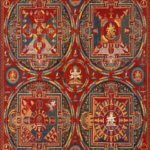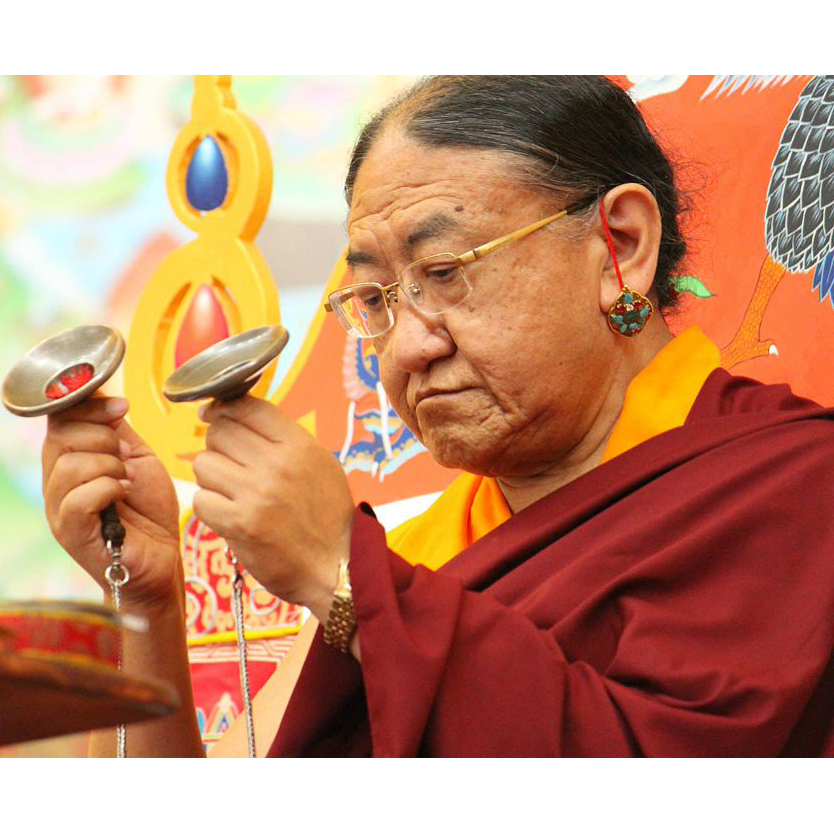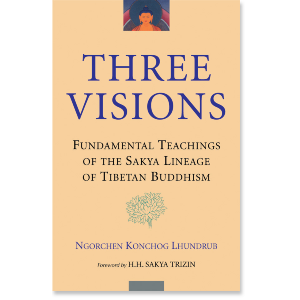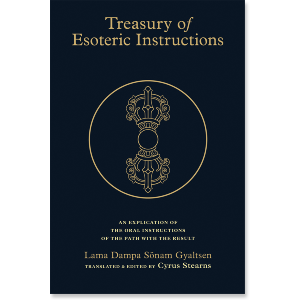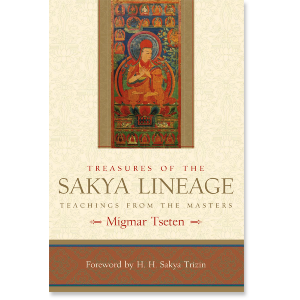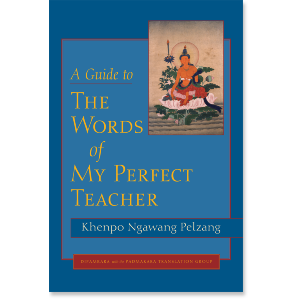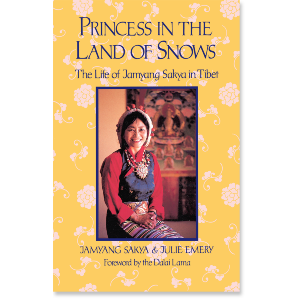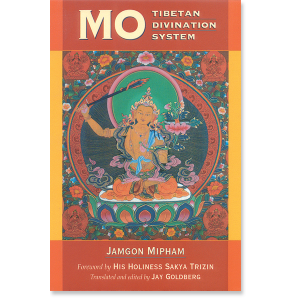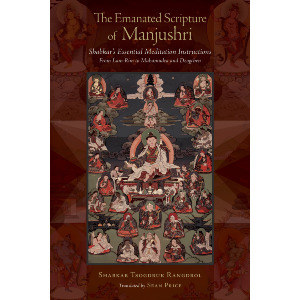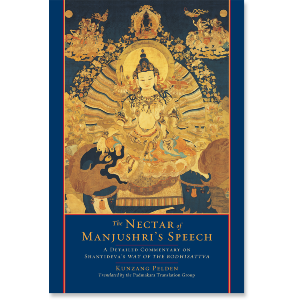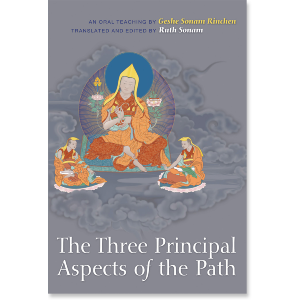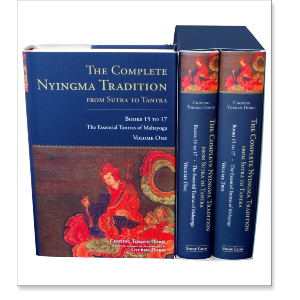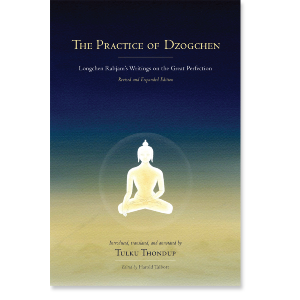| The following article is from the Spring, 2000 issue of the Snow Lion Newsletter and is for historical reference only. You can see this in context of the original newsletter here. |
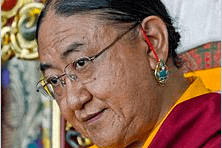
H.H. the Sakya Trizin (photo by Dolkar Sangmo)
His Holiness the Sakya Trizin
Visits North America
The summer of 2006 Buddhists of all traditions had the rare opportunity to receive teachings, blessings, and empowerments from one of the world's preeminent leaders and masters of Tibetan Buddhism, His Holiness Sakya Trizin. His Holiness is the head of the Sakya Order, the second oldest of the four main schools of Tibetan Buddhism.
His Holiness envisions yet another responsibility in disseminating Dharma well beyond the cultural difference, geographical distance, and spiritual adherence within an ancient Sakyan tradition of thorough studies, contemplation and meditation
This is the first time that His Holiness has visited North America in ten years. In addition to teachings and empowerments in New York, Boston, Washington, D.C., Minneapolis, Portland, Seattle, San Francisco, and Los Angeles, His Holiness will give a transmission of the Lam Dre(“The Path and Its Result”) body of teachings in Vancouver, B.C.
The history of the Sakya Order can be traced back to the 9th century and is inextricably bound up with the Tibetan royal clan of Khon.
The Venerable Lama Pema Wangdak, who is the head of the Sakya centers in the New York area, writes the following article.
The History of the Sakya Order
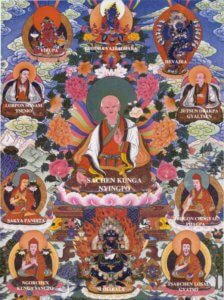
Sakya Lineage Tree. Attribution: uploaded by Panchito, Transferred from de.wikipedia to Commons. Link to license: https://creativecommons.org/licenses/by-sa/3.0/deed.en
The history of the Sakya Order can be traced back to the 9th century and is inextricably bound up with the Tibetan royal clan of Khon. The founders of the Sakya Order, the Gongma Nam Nga (Five Exalted Ones), were known as the descendants of the ancient Khon family, which was believed to have stemmed from an ancient race born in conflict between earthly demons and the descendants of the Clear Light Gods.
the ancient Khon family. . . was believed to have stemmed from an ancient race born in conflict between earthly demons and the descendants of the Clear Light Gods.
Historically, the Khons rose as a holy family during the reign of King Trisong De'u Tsen (790-845 CE.). Khon Lu'i Wangpo Sungwa became one of the first seven Tibetans to receive monastic training under the abbacy of Shantarakshita.
The Sakya tradition derives its name from the Sakya Monastery in central Tibet where the Khon Konchog Gyalpo (1034-1102) founded the monastery in 1073. The present head of the Sakya Order, His Holiness the Sakya Trizin, is the 41st master of the seat of Sakya and the direct descendant of the Khon Lu'i Wangpo Sungwa.
Khons are perhaps the greatest religious family throughout the entire history of Buddhism in Tibet. They are the longest in line of leadership of the social and spiritual life and have contributed much in shaping and sustaining the Tibetan civilization as a whole.
Khons. . . . the greatest religious family throughout the entire history of Buddhism in Tibet.
Lam Dre Teachings
The Sakya order is the second oldest of the four principal traditions of Tibetan Buddhism. At its heart is the lineal transmission of Lam Dre (The Path and Its Result), a system of knowledge of practicing the entire range of sutric and tantric teachings of the Buddha that was first enunciated by the 9th-century Indian tantric master and saint Mahasiddha Virupa, and was brought to Tibet from India by Gayadhara and Drogmi Shakya Yeshe the translator (990-1074).
a system of knowledge of practicing the entire range of sutric and tantric teachings of the Buddha
In the beginning of the second phase of Buddhism in Tibet (953), following Lang Dharma's near-destruction of the faith, there was a period of intense and active interchange between Indian and Tibetan spiritual centers. Lha Lama Yeshe O, a Ngari king, sent twenty-one young Tibetans to study sutras, tantras, logic, language, and medicine in Kashmir, India. Among them were Lochen Rinchen Sangpo (958-1055), the great monk who pioneered the second-phase translation, and Ngog Legpei Sherab.
At the request of Yeshe O's nephew Jangchub O, Nagtso Lotsawa then invited Dipamkara Shrijnana Atisha to come to Tibet from Vikramashila Monastery, the major center of Buddhist learning in India Ngog's young nephew Loden Sherab, one of the translators of thousands of scriptures into Tibetan, also made a journey to study in India where he found himself accompanied by four other major pioneers of transmission, Lotsawa Tsen Khawoche, Khyungpo Chotson, Ra Lotsawa, and Nyen Lotsawa.
following Lang Dharma's near-destruction of the faith, there was a period of intense and active interchange between Indian and Tibetan spiritual centers.
It was during this great spiritual revival, inspired by the teachers of that time and need for the further introduction of Buddhism into Tibet, that the great Drogmi Shakya Yeshe, accompanied by Taglo Zhonnu Tsondru and Leng Yeshe Zhonnu, set out to India through Nepal on a momentous journey that would end in the dissemination of the Lam Dre in Tibet.
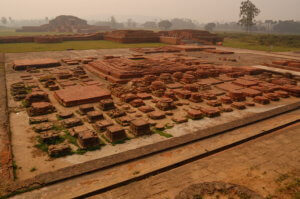
Vikramashila University
They studied Hevajra, Samvara, Guhaysamaja, Yamantaka, and Mahamaya tantras for a year under Shanta Bhadra in Nepal. Escorted by their teacher's brother, Mahapandita Abhayakirti, they traveled to Vikramashila Monastery, with a stopover in Bodhgaya for their initial prayer and salutations to the Mahabodhi shrine.
For eighteen years, Drogmi studied monastic disciplines, Prajnanaparamita, and Samvara and Hevajra tantras from Shantipa. Drogmi mastered the root, narrative, instructive, and the supplemental fragmental tantras. Among his other teachers were Vagendra Kirti, Prajiiakara Gupta, Narotapa, Jnanashri, and Ratnavajra.
When the great Master Viravajra realized that Drogmi was a most able and worthy student, he introduced Drogmi to the teachings of the great 9th-century adept Virupa. The entire instruction on Triple Tantra of Hevajra Root, along with its exegesis, was given.
When the time finally approached for Drogmi's return to Tibet, his master instructed him in about eighty major tantras along with exegetical commentaries, numerous meditative manuals with their rites, and about fifty dharanis in connection with sutras.
As a going-away dharma-gift, Drogmi received a Lam Dre teaching (without the root text), its auxiliary instructions, and profound teachings on the transference of consciousness.
"Rejoice, for I have successfully transmitted all the teachings I have to give. Now go to Tibet and integrate your practice and teaching. I will come sometime to help clear up your doubts. Since you are the holder of the teachings of the Yogeshwara (Virupa), there will come a master who will bring the entire teaching to your doorstep."–Viravajra, Drogmi Lotsawa
With these words from Viravajra, Drogmi Lotsawa left India for the last time.
early one morning the sound of a ram's horn. . . . heard at the great master's residence in Mukhulung, proclaiming the arrival of a pandita or Indian master.
Drogmi's Return to Tibet
Drogmi's return to Tibet and his teachings inspired numerous scholars and saints, among whom were the Great Maxpa Lotsawa and Go Khugpa Letse. A monastic university was established in Mukhulung in Mangkhar, and students poured in from upper, central, and eastern Tibet.
As Drogmi's teacher Viravajra had prophesied, early one morning the sound of a ram's horn was heard at the great master's residence in Mukhulung, proclaiming the arrival of a pandita or Indian master.
Pandit Gayadhara was on his way to Purang. He and Drogmi proposed a rendezvous some time in the coming two or three years, when Gayadhara would accomplish his "visit to Purang and chores in Nepal." After two years, two messengers arrived with news of Gayadhara's arrival.
The Teaching of the Lam Dre
The entire Lam Dre was taught, including the root verses, for a period of three years. The initiations, instructions, and commentaries of the Triple Tantras were simultaneously translated.
Mukhulung was thus firmly established as the seat of Lam Dre teachings and practices. Before Gayadhara left, he prophesied Drogmi as the one who "will traverse the divine realm of Khechara within this very life without having to leave his body behind."
Drogmi. . . . will traverse the divine realm of Khechara within this very life without having to leave his body behind.
Although tantric and sutric teachings were well established in Tibet before Drogmi, the corpus of the Lam Dre system of Mahasiddha Virupa was not known until he began to teach it.
Twelve different major schools of transmission of Lam Dre arose in Tibet. Preeminent among these was that of the Great Sakyan Kunga Nyingpo (1092-1158), who studied with Zhangton Chobar.
The Great Sakyan's line of transmission is also called the "direct line," because Virupa, Damarupa, and Gayadhara appeared to him in visions and gave a month-long transmission on seventy-two Anuttarayoga tantras and the four profound Dharmas of Sakya that until recently was known to be transmitted only within the confines of the first monastery at Sakya.
Through a successive line of teachers of the Lam Dre system, it has passed down to the present in an unbroken line of transmission.
In the 15th century, Ngorchen Kunga Zangpo (1382-1457), the founder of the Ngor school of the Sakya Order, caused Lam Dre to become widespread during his life-long career of transmitting its teaching.
Later the Lam Dre developed into two major lines of transmission: Ts'og She, the general presentation, and Lob She, the esoteric presentation. The latter was enunciated by Muchen Sempa Chenpo (1448-1530) to teach the most uncommon and detailed aspects of the system to his chosen disciple Dagchen Lodro Gyaltsen. Tsarchen Losal Gyatso (1502-1556), the founder of the Tsar school, and his two foremost disciples, Khyentse Wangchug and Lhundrub Gyatso, became the prominent expounders of Lob She.
As Lam Dre teachings spread throughout Tibet, Mongolia, and China, and were eventually written down, the volume of Lam Dre scriptures grew to encyclopedic proportions (a single collection of the Lam Dre alone comprises thirty volumes).
Through a successive line of teachers of the Lam Dre system, it has passed down to the present in an unbroken line of transmission. Among the eminent living masters of the Lam Dre tradition are His Holiness Sakya Trizin (born in 1945), the present leader of the Sakya Order, H.H. Dagchen Rinpoche, H.E. Chogye Trichen Rinpoche, and H.E. Luding Khen Rinpoche.
A unique and systematic teaching of the entire Buddhist path
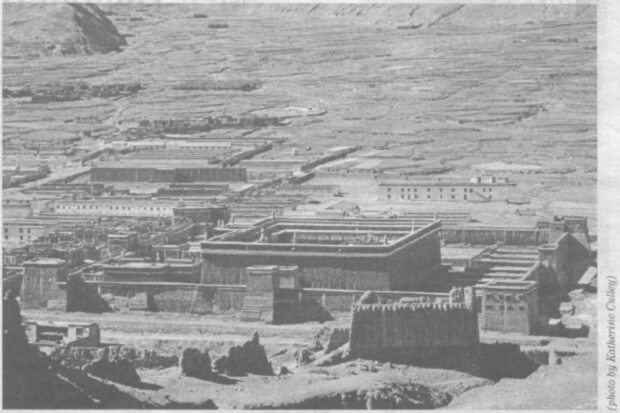
Lhakhang Chenmo, The Great Sakya Monastery, Sakya, Tibet (Founded 1269 C.E.)
The Lam Dre system is derived from the Hevajra Root Tantra. A unique and systematic teaching of the entire Buddhist path, it presents the essence of the tripartite Buddhist Canon, comprising ethical discipline (vinaya), the Buddha's original discourses (sutra), and psychology/cosmology/ metaphysics (abhidharma). It is a complete and gradual system of exoteric (sutric) and esoteric (tantric) methods that constitute a viable spiritual path for the aspiring devotee.
Its teachings have been passed down in an unbroken line of transmission of empowerments and blessings, with special emphasis on the "four authenticities"—authentic teachers, experiences, scriptures, and treatises. Central to the Lam Dre system is its unique and profound view of the "non-difference of samsara and nirvana," within which perfect enlightenment or Buddhahood is to be realized. There the nature of mind, for its practical implication, is explained both as the "root of samsara and nirvana," and the "union of luminosity and emptiness."
the nature of mind, for its practical implication, is explained both as the "root of samsara and nirvana," and the "union of luminosity and emptiness."
Sakya Order
After the era of Rinchen Zangpo, Drogmi, Marpa, and Go, Tibet entered a period when fewer panditas visited Tibet and the teachings and literature inherited from India were consolidated; the Sakyans in Tibet took to writing, meditating, and teaching. The masters of the Sakya were at the forefront of Buddhist propagation and contributed much to enhance the spread of the later phase of Tibetan Buddhism.
By the end of the eleventh century, there were clusters of great Sakyan spiritual masters in Tibet. Khon Konchog Gyalpo (1034-1102) excelled in both the old and new tantras. His son, Great Sakyan Kunga Nyingpo (1092-1158), was already an accomplished saint at the age of twelve, when he received the famous Lojong, the four-line teaching of "Parting from the Four Desires," and countless others directly from Manjushri. His era was the heyday of spiritual learning. There were occasions when the Great Milarepa or the Great Sakyan Kunga Nyingpo would be teaching in the same area at the same time.
the heyday of spiritual learning
Great Sakyan's sons Lopon Sonam Tsemo (1142-1182) and Jetsun Dagpa Gyaltsen (1147-1216) succeeded the holy throne of Sakya respectively. Dagpa Gyaltsen's fame even reached India due to his learning and realizations on the Vajrayana teachings, and he was unequaled in all time in his studies of the tantras.
Sakya Pandita Kunga Gyaltsen (1182-1251) became Tibet's all-time great teacher. He was a saint, scholar, translator, poet, artist, and erudite in the fields of logic, language, and drama, besides being a statesman. His classic works, Three Codes of Discipline, Treasury of Logic and Reason, and Treasury of Elegant Sayings, became thematic writings of the Tibetan renaissance.
Drogon Chogyal Phagpa (1235-1280), while still at the age of seventeen, became the next successor of the seat of Sakya, the temporal leader of Tibet. In China alone he ordained thousands of Hans, Koreans, Indians, Uygurs, Xixia, and Dali peoples.
Masters of the Teachings
The Sakyas became masters of the teachings of the Samyaka and Vajrakilaya of Padmasambhava, Lam Dre of Virupa and Drogmi, the Guhyamantratilaka of Pandita Guhyaprajna, Samvara of Purang Lotsawa, the new transmission of Guhyasamaja and Chakrasamvara of Ma Lotsawa, the Madhyamika and Pramana of Ngog Lotsawa, the Abihidharmas of Kawa Pal-tsek, Chokro Lu'i Gyaltsen, and Zhang Gyalwa Pel, the Vinaya of Jhim Lotsawa, and the teachings of Shije, Dzogchen and Chod.
The Great Sakya Monastery
The Lhakhang Chenmo (the great Sakya monastery in Sakya) remained the center of the teaching after its foundation in 1268 by Chogyal Phagpa. Ma Lotsawa, Pang Lotsawa, Shongton Lotsawa and other great translators worked in translating the tantric texts of Hevajra and Kalachakra, Pramanavartika; Kalapa, the Sanskrit grammar Kavyadarsha, and Nagananda. The seat of Sakya sometimes is referred to as the "spring of wisdom."
The spiritual legacy and the cultural and social contribution of Sakya have had a permanent impact on Tibet, Mongolia, and China.
Sakya Pandita propagated a new transmission of the monastic ordination from the Kashmiri abbot Shakyashry Bhadra, one of the last great Indian masters to visit Tibet. This monastic lineage was later known as the Panchen Dom-gyun or "Vow Transmission of the Great Pandita."
Sakya Pandita's teachings spread the Dharma throughout Tibet . . . lead[ing] the Tibetans towards a politically and culturally conscious society.
The Mid-13th Century
In the mid-13th century Sakya Pandita's teachings spread the Dharma throughout Tibet and also lead the Tibetans towards a politically and culturally conscious society. His masterly statesmanship, at the risk of his own life, saved Tibet from invasion at a time when few countries could survive the Mongolian domination of Asia.
His Letter to the Tibetans was instrumental in the fate of Tibet, and helped Tibetans to contain confrontation with the Mongols. It was he who, through his skill and wisdom, "conquered" the invading Mongols, leading to the eventual unification of Tibet for the first time since Lang Darma's fall.
It was this unparalleled event in the history of Tibet, and the unexceptional ingenuity of Sapan's spiritual and social leadership, that continues to shape Tibetan culture to this day.
Sakya Pandita's. . . .masterly statesmanship, at the risk of his own life, saved Tibet from invasion
Tibetan Buddhism in Mongolia and China
For the first time Tibetan Buddhism was formally established in Mongolia and China, where Sakya Pandita himself remained for the last six years of his life, from 1246 to 1252. As a creative writer and innovative thinker he gave Tibet and inspired a literary world of poetry, drama, medicine, astrology, art, language, and logic.
In 1260, Chogyal Phagpa formally led Tibet toward a unified social structure by assuming its spiritual and temporal leadership. For the first time in three hundred years, Tibet came together under one leadership. Phagpa's vision of a spiritually oriented society remains a model of administration up to the present day in Tibet.
Many reforms were made in the Mongols' court at the advice of young Chogyal Phagpa. He devised a new Mongolian script for Kublai Khan (1215-1294) and initiated the translation of Tibetan Buddhism into the Mongolian language. His wisdom, compassion, and skillfulness in the teachings won the confidence of the emperor and people there.
His broad vision reversed the Mongol king's sectarian proposition of one religion i.e., the Sakya for all of Tibet and China.
Chogyal Phagpa's. . . . wisdom, compassion, and skillfulness in the teachings won the confidence of the emperor and people there.
Great Saints and Masters from the Sakya Order
Numerous other great saints and masters appeared from the Sakya Order: Lama Dampa, Choje Kunga Tashi, Salo Jampal Dorjee, A-myes Shap of the holy Khon family; U'yugpa Rigpei Senge, Yagton, Rongton, Jetsun Rendawa, Je Tsongkhapa, Khedrup Je, Gyalts'ab Je, Gorampa, Shakya Chogden, Ngorchen Kunga Sangpo, Sasang Mati Panchen, Taktsang Lotsawa, Bodong Panchen, Kunga Namgyal, Zungpal, Sangye Phel, Panchen Bumtrak Sumpa, Kunga Chosang, Ludrup Gyatso, and Tsarchen Losal Gyatso.
Rendawa Zhonnu Lodo (1349-1412) was renowned as the promoter of the Prasangika-Mad-hyamika philosophy of Nagarjuna. He introduced the formal degrees of Kachupa, Kashipa, and Rab-jampa into the Buddhist philosophy curriculum.
Rongton (1367-1449) founded Nalanda University in Tibet. It is said that at no other time in history was there a greater number of students studying philosophy than under Chapa Choseng, Chomden Rigrel and Rongton.
no other time in history was there a greater number of students studying philosophy
The Founding of Monasteries
Ngorchen Kunga Sangpo founded the monastery of Ngorin 1429. Monasticism prospered in his lifetime after he ordained twelve thousand monks. The Ngor monastery, the seat of Ngor School of the Sakyas, became the major center of monastic and tantric training. The annual Lam Dre teaching continued since its foundation.
Thupten Namgyal Ling monastery in Tanag was founded by Gorampa Sonam Senge (1429-1489).
Throughout Tibet monastic schools of the Sakya Order were established, especially in the eastern province of Kham. Important centers arose at Dege Gonchen, Dzongsar, Dokho, Kyegu, and De'uchoje. The sub-schools of Ngor, Tsar, and Gangkar have flourished up to the present.
Although the Jonang-pa, the Bulug-pa, and the Bodon-pa have ceased to exist as separate traditions, they left monumental works on Tantra and other literary, scientific, and philosophic writings that were to profoundly influence other schools of Tibetan Buddhism.
the Sakyas have contributed a rime (ecumenical) consciousness to Tibetan Buddhism
Under the inspiration of Jamyang Khyentse Wangpo, Loter Wangpo, Ngawang Legpa, and the late Dezhung Rinpoche (1904-87), the Sakyas have contributed a rime (ecumenical) consciousness to Tibetan Buddhism. Loter Wangpo's monumental Collection of Classes of Tantras and Collection of Sadhanas exemplify the spirit of the rime movement in Tibet.
Sakya Order at Present
The Sakya tradition flourished under the leadership of His Holiness Sakya Trizin [until March 2017], who is the forty-first in a line of throne holders of the seat of the Sakya Order, and His Holiness Dagchen Rinpoche, head of the Phuntsok Podrang, His Eminence Chogye Trichen Rinpoche, and His Eminence Luding Khen Rinpoche.
Ever since he left Tibet at the age of fourteen, His Holiness Sakya Trizin's works have spread well beyond the Himalayan range. To sustain and nourish this spiritual heritage, the seat of Sakya Order has been reestablished in Northern India along with the two sub-orders Ngor in India, and the Tsar in Nepal. Centers for Buddhist studies have been established in Southeast Asia, Europe and in North America. New schools, monasteries, meditative retreats, and the monastic trainings and colleges have been established in India for higher studies.
The activities of outstanding teachers such as the late Khen Rinpoche Rinchen (1926-85) and Khenpo Appey Rinpoche, and more recently Khenpo Kunga Wangchug have heralded the spread of the various branches of Buddhist learning and practice: Vinaya (ethical discipline), Abhidharma (psychology/cosmology/metaphysics), Prajnaparamita (the heart wisdom of Buddhist teachings), Pramana (logic and epistemology), Madhyamika (the philosophy of the Middle Way), and above all the tantric studies in some of the higher study centers of Sakya College, Sakya Institute, and Dzongsar Institute.
the saviors of the land of the snows. . . .preserving and sustaining the Buddha's teachings of peace, happiness and liberation for all sentient beings.
The New Generation of Sakya
A new generation of Sakya are growing up, ever ready to follow the tradition of the saviors of the land of the snows in preserving and sustaining the Buddha's teachings of peace, happiness and liberation for all sentient beings. Many worldwide centers for the study and practice of Tibetan Buddhism have been established.
His Holiness envisions yet another responsibility in disseminating Dharma well beyond the cultural difference, geographical distance, and spiritual adherence within an ancient Sakyan tradition of thorough studies, contemplation and meditation, that we in the West had the good fortune to share especially during His Holiness' visit with us.

